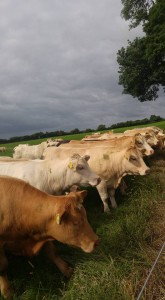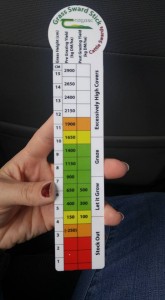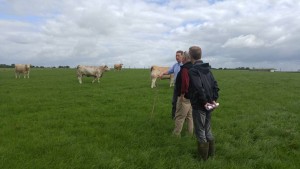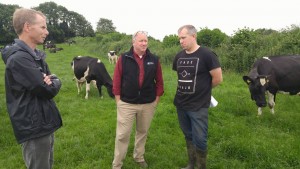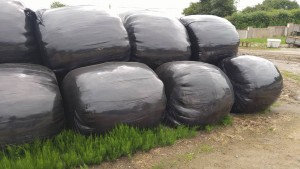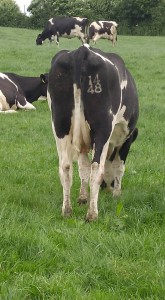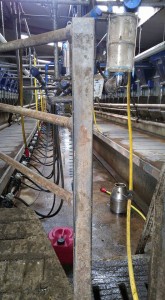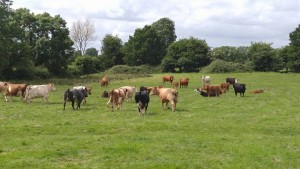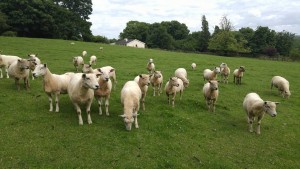This morning Brad and I met with Christy Jones, TEAGASC Drystock Advisor, to visit several local farms. He works in the Mullingar Office with David Webster. We started our day at the farm of Christie Tormey who buys heifers at around 470 kg (1,036 lbs) and grazes/feeds them till slaughter. He is a Quality Assuarnce Producers and receives several premiums from Kepak. He has divided his farm into 3 ha paddocks. The heifers graze with little use of nuts (concentrates). The heifers will spend 9 to 10 months on his farm. In the U.S., we must slaughter under 24 months old with 18 months preferred due to Asian markets and concerns about disease. Ireland animals need be slaughtered by 30 months old giving farmers the opportunity to finish them on grass instead of grain. His heifers will finish out at around 760 kg (1,700 lbs) and have a 389 kg (855.8 lbs) carcass weight. The grading system in Europe is less dependent on ribeye area and marbling. They focus more on muscling, yield, and desire lean meat. Most of Christie’s heifer will grade a U, which is the top grade for muscling. Christie believes fully in using lime and reseeds some part of his farm every year. Ireland uses perennial ryegrass has their dominant forage with many varieities breed by TEAGASC. TEAGASC even uses something similar to a grazing stick, but it looks more like a ruler. Perennial ryegrass does not get as tall as the forages we typically use in Virginia. Christie has very good understanding of cattle handling and his heifers where the calmest cows I believe I have ever seen to only be grazing.
Next, we traveled to visit an intensive dairy. Ciaran Seery and his father, Seamous, both operate the 118 cow dairy on 31 ha (76.6 acres). Yes, that’s right they have stocking rate of 1.5 cows per acre! The farm does it mainly on grass and uses Friesian cows. Friesians are smaller then Holsteins, but are heavy millers. It takes the family 1 hour to milk the herd in their new palor that they installed in 2009. The cows do receive about 2 kg of grain during milking in normal weather and 4-5 kg of grain in the winter months. The whole herd is turned off dry for two months and the they calve all in a 13 week time frame. They artificially breed most of their herd, but use an Angus bull for cleanup. The cows are giving about 23 liters of milk a day with a season average of about 5,000 liters. The farm makes grass sillage and cure the sillage in a pit similar to Virginia. They also make haylage and wrap bales. In Virignia, we use white plastic to reflect heat, but in Ireland they use black to help keep heat in. The family uses the official eid tags, but also freeze brand their cattle. You can tell each cow as they come and go!
Lastly, we went to the farm of Mike and Heather Scott. They have 25 beef cows and 100 sheep. The family has also been involved heavily in stud thoroughbred racing horses. Their walls are covered in awards for horses. Mike is also involved with Bothar, which is a group that raising money to buy bred dairy heifers to send to Romania and other similar countries. Those who receive these animals must then pass another heifer on to someone else in need. The group funds about 50 heifers every year. He will be going to Romania himself soon to help with the project. Mike is involved with several environmental schemes (programs) offered by the government. He keeps his farm mainly in traditional meadow and does not use mineral fertilizers. He gets a payment of 300 euro per ha for this. He also has planted spruce on his farm and receives 250 euro per ha for 20 years. Mike also has planted oats, barley, and linseed for wild birds and get 900 euro per ha for that project as well. Mike loves his animals and one of his greatest sorrows was the lost of his herd to BSE (mad cow disease) about 12 years ago. When the disease was discovered on his farm, he was not allowed to keep any of his stock. He was able to buy back a heifer from a cow he sold to someone and he keeps her as a reminder of his old herd.

